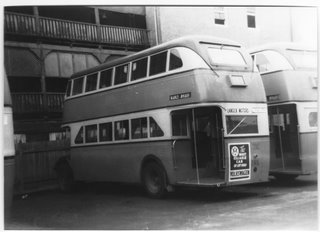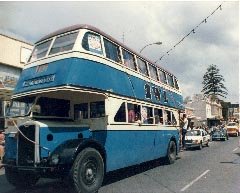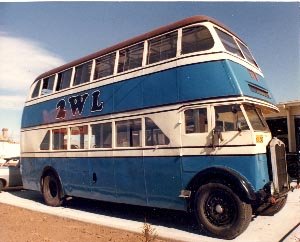
Australian Albion fans show off their wares to the visiting Scotsmen. From L to R: Robert Hood with 2023, Rick Robinson, David Griffiths and 1892, David Wilson and 1187, Ben Barnes, Craig Parkinson and 1615.
In 2003 the idea of a tour to Australia by Albion enthusiasts from Scotland was mooted. Organised by Andrew Stewart of Fly Discover Travel, Adelaide, himself the erstwhile owner of an Albion CX19 double decker, which became famous as Albert, veteran of 15 return journeys from London to Bombay in the late 1960s /early 1970s, this tour was to show what Australia had to offer by way of preserved Albion vehicles.
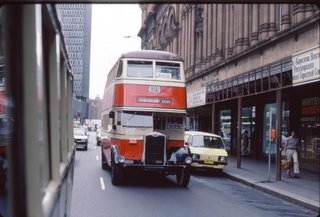
Albion Venturer model CX19GW ex NSW Dept of Road Transport and Tramways fleet number 615, registered number m/o 1615, in George Street City on an enthusiast outing marking the 50th anniversary of the establishment of NSW government bus services, in 1983. photo Bill Parkinson.
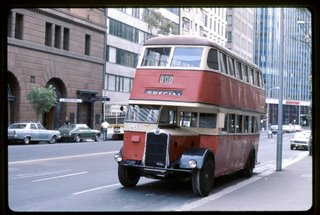
1615 was acquired for preservation from West Bankstown Bus Service by two members of STM in 1975 and donated to the Museum as an example of the first tramway replacement buses, used after the closure of Manly trams in 1939. photo Bill Parkinson
Australian Albion enthusiasts were aware that they had a rare treasure to be unearthed. Not seen out on the road for many years was the former NSW Department of Road Transport and Tramways bus once registered as m/o 1615.
It is a 1939 Albion Venturer, model CX19GW, the "G" meaning it has a Gardner engine, and it was shut away in the unused sheds of the Sydney Tramway Museum at their old site in the Royal National Park, at Loftus, south of Sydney. The impending visit of the Scotsmen acted acted as a catalyst for its return to operable condition.
To his eternal credit, a young member of the Sydney Tramway Museum, Craig Parkinson, the son of Bill Parkinson who had put in countless hours of work on m/o 1615 in the 1970s and early 80s to restore it to its original colours and maintain it mechanically, came forward.
Craig single-handedly dug out the bus from its dark and dusty shed, cleaned out the fuel system, pumped up tyres, installed batteries, and started the engine for the first time in nearly 20 years. Helpers then removed an entire wall of the shed to facilitate its removal without having to move tonnes of other accumulated material, and with much toing and froing, 1615 emerged into the daylight in December 2003.
The wall of the shed was reinstated, and 1615 was driven to the new site of the Sydney Tramway Museum and placed over an inspection pit, in covered storage.

The bus after having 20 years of dust washed off sits in the top shed at STM with every prospect of a major restoration about to happen......
##############
This article appeared in Australian Bus Heritage magazine, issue 2 March 2004.
It is included here to provide a more comtemporaneous account of 1615's rescue.
SURE AS THE SUNRISE
An Albion CX19 double decker rises from the dust
On Saturday 3rd January 2004, m/o 1615 (“1615”), the last remaining 1939 model Waddington-bodied Albion Venturer was extracted from storage at the old Royal National Park site of the Sydney Tramway Museum. 1615 was one of only 17 pre-WWII CX19s supplied to the N.S.W. Dept of Road Transport and Tramways by Albion Motors Ltd of Scotstoun near Glasgow. Some had Albion oil engines, then still in their early stages of production, but most had Gardner 6LW diesel engines. 1615 is the last survivor of the group and is now the only pre-war CX19 in the world.
Thanks largely to the efforts of Bill Parkinson and the band of South Pacific Electric Railway (SPER) members who recognised the heritage value of the vehicle, as one of the buses bought to replace the Manly Trams after closure in 1939, 1615 has been preserved as a complete omnibus, even with its original seats.
Informal discussions occurred from time to time with directors of SPER about the future of 1615. There was never any clear idea of what could happen. What should happen was quite simple: it would need restoration, but the question of who should do it, and where, and who would provide the resources remained uncertain, and at the time of writing is still uncertain. The Sydney Tramway Museum’s resources are more than fully committed to its ever-expanding tram fleet, and the equipment for restoration of buses with steel frames is different to that needed for wooden-bodied trams.
Then one of those happy accidents occurred—some members of the Albion Club in Scotland decided to organize a Tour Down Under, to arrive in January 2004, so as to be in Sydney for Motorfest on January 26th. They knew Australia was a treasure chest of preserved Albion trucks and buses thanks to the company’s vigorous export activities, and they wanted to come and have a look. They knew about 1615, and the Model 80 bus at Tempe, m/o 1187, thanks to correspondence between U.K. and Australian Albion enthusiasts over the years, and were anxious to see them. Twelve months ago all they were going to get was a glimpse of 1615 covered in dust, buried in the back of an unlit shed, and a static view of 1187, the 1935 model 80. unable to be run because of cooling problems.
This sad scenario was enough to arouse the energies of members of both SPER and Historic Commercial Vehicle Association (HCVA) to do something about it. Howard Clark, chairman of SPER, was adamant that the visitors should be shown a good time. On December 17, 2003, SPER and HCVA members Howard Clark, David Griffiths, Peter Kahn, Craig Parkinson (son of Bill), Bruce Pinnell, Vic Solomons, and David Wilson met at the old R.N.P. site at Loftus to assess the chances of getting 1615 out of its awkward location, of moving it to Tempe for display, and of running it during the visit of the Albion Club members. A meeting afterwards at Sydney Tramway Museum, and a submission then the board of SPER, resulted in permission to remove the bus on January 3rd 2004.
Rather than try to clear a path forward, past tonnes of stored equipment and two other double deckers, 2619 and 2806, it was decided to remove a section of the shed wall behind 1615, and back it out. Craig Parkinson then showed himself to be one to accept a challenge. Craig put in a lot of hours to check the fuel system and cooling system, fit batteries, and try to run the engine which had not turned for 12 years. It started almost immediately. On January 3rd a team of Ben Barnes, David Griffiths, Chris O’Brien, Chris Olsen, Bill Parkinson, Craig Parkinson, and Roland, the caretaker at the R.N.P. site, rapidly removed the wall cladding, pumped up tyres, started the engine, and backed it out, running on clean fuel from a 5 gallon drum set up by Craig beside the engine. The reversing process required about ten to and fro movements to clear the shed and its posts, after which Craig had blisters on his hands from the steering wheel.
A number of trams was driven out of the Tramway Museum to permit 1615 to be parked over the inspection pit for checking fluid levels, brakes, exhaust, etc. Craig put in many hard hours chiseling encrusted mud and grease from the running gear and then used Tempe’s steam cleaner to freshen up the engine bay and under-body area. Craig drained the old oxidized fuel from the tank and filled it with fresh diesel, and fitted a set of nearly new rear tyres from the chassis of 1619, lying at Loftus old site.
It was now ready for driving, on trade plates, from Loftus to Tempe, a move which occurred on Saturday 17 January, with Bruce Pinnell at the wheel. When you look at 1615, think of Craig. His energy, skill and enthusiasm has been a prime contributor to the present state of the bus.
Once at Tempe, Ben Barnes and David Wilson put in some hard yards cleaning out the interior of dust and junk. On Saturday Jan. 24th, 1615 was run around the yard at Tempe so that some old hands could renew acquaintance with the idiosyncrasies of its gearchange, and some new hands, e.g. Craig, could get to grips with it, prior to the arrival of the Scotsmen on Sunday 25th.
Late in the day, on a last run around the yard, it quietly died, right in the middle of the yard. The Amal fuel lift pump had packed it in. The first plan was to remove the pump from the derelict chassis of 1619, sitting in the open at the old RNP site, Loftus. The second plan, to call Michael Myer of Turnwell Diesels Woy Woy, established that he had in stock kits for Gardner lift pumps, so Craig and Ben Barnes made the bold decision to head for Woy Woy at 6 p.m. Saturday. The kit was taken back to Parkinsonville, Wollongong, fitted to the pump, which was returned to Tempe by 8 a.m. Sunday, to be refitted, pumped up and bled of air from the injection system. 1615 started, ran fine, and hasn’t missed a beat since.
Next day, the Scots were deeply impressed. Some of them, experts at constant mesh boxes, had a run around the yard, but only one, Paul Adams, can claim to have mastered the gear change immediately, at first acquaintance. The Gardner engine with its heavy flywheel and relatively low compression ratio, makes the up gear change very slow compared to a post-war CX19 with Albion oil engine.
The challenge is now to formulate a plan for the restoration of 1615 which is acceptable to its owners, SPER, and the owners of the bus restoration facilities, HCVA. Discussions with three groups, the Boards of the two Museums, and the group of individuals interested in this unique vehicle, will continue for some time until a mutually acceptable arrangement is found. There is great good will on all sides, which bodes well for the future, when it is hoped that both societies can look forward to occasional joint ventures involving trams and buses.
As a postscript, readers will be interested to hear that m/o 1187, the oldest surviving Albion double decker in the world, is now operable, after having its cooling problems cured. The completely useless water pump, corroded and leaking furiously, has been overhauled and refitted, and the tendency to boil on normal running has been cured.
Its Gardner 6LW engine has a water circulation manifold on each block of three cylinders, and the entry from the back block to the front one was totally obstructed by corrosion. A pair of bronze manifolds, as opposed to the original ones, of cast aluminium alloy, was supplied and fitted by Michael Myer, mentioned above, and the bus now runs like a rocket. If its brakes are up to the task, it may be registered and be run on restricted duty.













